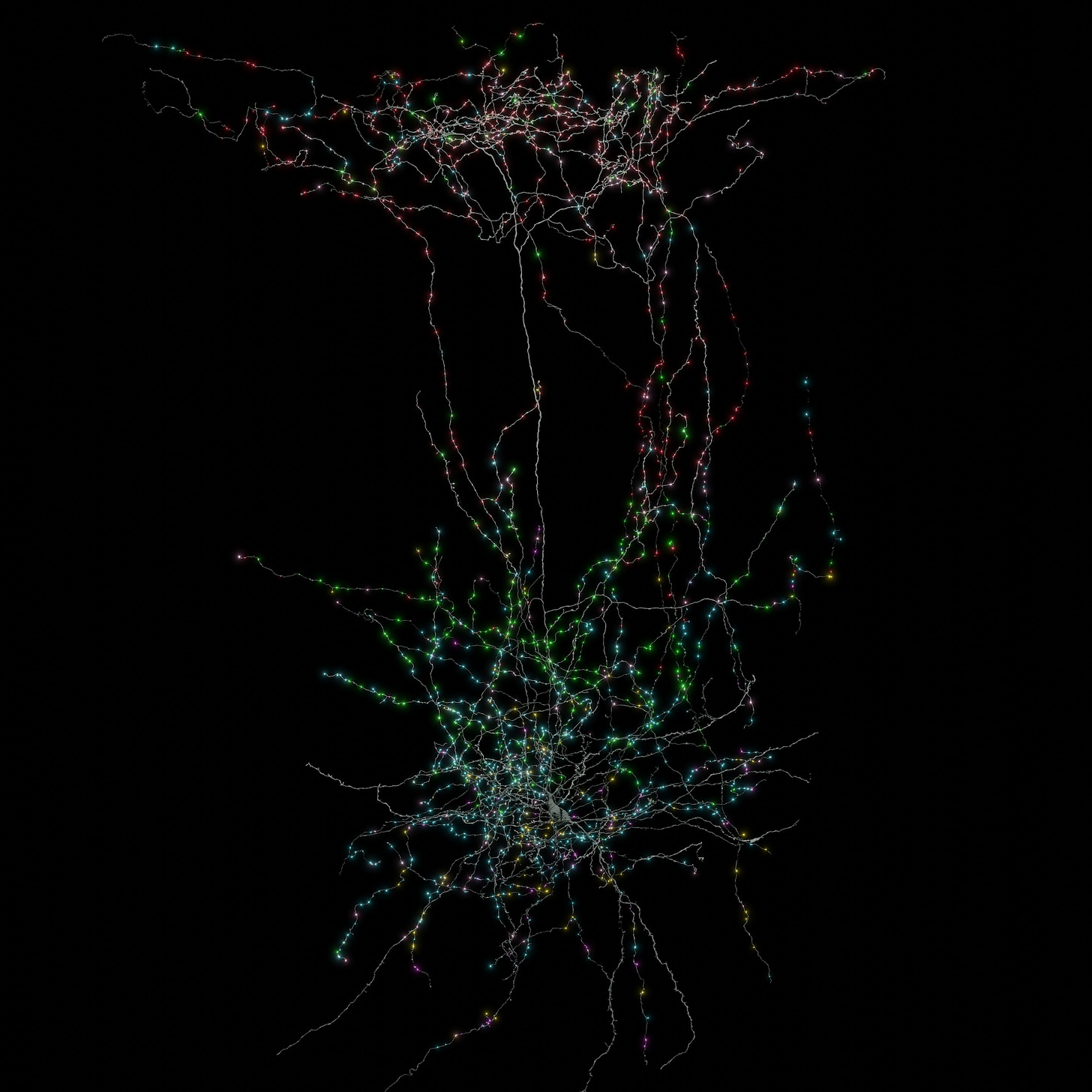Extreme Weekly #20
Ancient Tools, Clean Energo, Mouse Brain Map & More
April 13th 2025
Wow, release 20. Time Flies.
I hope everyone is doing alright and they’ve had a great week. I also hope this read will brighten your Sunday, even just a little bit.
Now, let’s go!
01. Mouse Watches Sci-Fi to Map Brain
In a groundbreaking study, scientists have created the most detailed map of a mammalian brain to date by analyzing a tiny portion of a mouse's visual cortex. Researchers from the MICrONS consortium recorded brain activity from 76,000 neurons in a cubic millimeter block of the occipital lobe while the mouse watched video clips, including scenes from "The Matrix" and "Star Wars." This enabled them to trace over 200,000 cells and 523 million synapses, creating a 3D map that offers new insights into neural circuitry.
The study revealed that inhibitory neurons form connections with targeted neuron types rather than randomly, providing crucial insights into how brain structure relates to function. The dataset, which is publicly available, may help understand neurological disorders like autism and schizophrenia. This research marks a significant step toward modeling human brain function and emphasizes the complex and structured nature of neural connectivity.
02. Ancient Tools Reveal Prehistoric Social Networks
Archaeologists excavating a cliffside cave on South Africa’s southern coast have uncovered thousands of stone tools dating back approximately 20,000 years. Detailed analysis of these artifacts reveals that prehistoric humans shared intricate tool-making techniques across vast regions, indicating a complex web of social interactions.
The tools found in the Robberg technocomplex showcase specific core reduction methods—techniques for shaping stone cores into blades—that are remarkably similar to those discovered hundreds of miles away in areas like Namibia and Lesotho. This consistency suggests intentional knowledge transfer among distant groups.
03. Walmart and Zipline Launch Free Drone Deliveries in Texas
Walmart has partnered with drone delivery company Zipline to offer free aerial deliveries in Mesquite, Texas. Residents within a two-mile radius of the local Walmart Supercenter can now receive over 65,000 products—including groceries and household items—delivered to their doorsteps in 30 minutes or less. This service utilizes Zipline's new Platform 2 drones, which hover at 300 feet and lower packages via a tethered delivery droid, ensuring precise and quiet drop-offs even in challenging weather conditions.
The initiative aims to enhance convenience for customers, particularly busy parents and individuals with mobility challenges. Deliveries can be scheduled through the Zipline app between 10 a.m. and 8 p.m. on weekdays, and 8 a.m. to 8 p.m. on weekends. This marks a significant expansion of Zipline's U.S. operations, building on its experience delivering medical supplies in countries like Rwanda and Ghana.
04. Japan's 3D-Printed Train Station Assembled in Just 6 Hours
In a groundbreaking move to modernize rural infrastructure, Japan's West Japan Railway Company (JR West) has introduced the world's first 3D-printed train station building. Located in Hatsushima, south of Osaka, the new structure replaces a 75-year-old wooden station that had fallen into disrepair. The innovative shelter was assembled in just six hours, a significant reduction from the typical two-month construction period for similar projects.
The 10-square-meter building, standing at 2.6 meters tall, was created using reinforced concrete molds 3D-printed by Serendix, a company renowned for rapid additive manufacturing. These molds were transported to the site and assembled overnight. The exterior features decorative reliefs of local specialties, including a mandarin orange and a beltfish, adding a cultural touch to the modern design.
Quizzz
Q1: Do Ants Have Lungs?
Q2: Do Snails Have Teeth?
Q3: Is Having Three Nipples A Real Thing?
Q4: Is A Straight Line Really Straight?
05. NASA Offers $3M to Tackle Lunar Waste
NASA has launched the "LunaRecycle Challenge," offering a $3 million prize to innovators who can develop a method to recycle 96 bags of human waste—comprising feces, urine, and vomit—left on the moon by Apollo astronauts in the late 1960s and early 1970s. These waste bags were abandoned to reduce weight and make space for lunar samples on the return trips. As part of its Artemis program, which aims to return humans to the moon, NASA is committed to sustainable space exploration and seeks to minimize and repurpose space-generated waste.
The agency's goal is to convert this waste into beneficial resources such as water, energy, and fertilizer, ultimately reducing toxic byproducts and limiting the return of waste to Earth. The challenge attracted global participation, and the submission deadline was March 31. NASA will now review the proposals to identify feasible waste-processing technologies for future missions.
06. Universal Theme Park Coming to the UK
Universal Studios has officially announced plans to build its first European theme park, and it’s landing in Bedford, UK. Slated to open in 2031, the 476-acre mega-park is expected to feature themed zones based on James Bond, Paddington, The Lord of the Rings, and even Back to the Future.
Designers say the rides won’t just be about speed and size, but storytelling immersion — transporting visitors into fully realized fantasy worlds. The layout will reportedly include a central lake, “portal” entrances to different lands, and coasters designed as narrative experiences rather than just thrill machines. Every detail, down to tree placement and background audio, is crafted to maintain the illusion.
Universal’s new UK park could redefine theme park design for Europe — where your entire journey is scripted from the moment you walk in.
07. Clean Energy Hits 40%, But Emissions Still Break Records
For the first time since the 1940s, over 40% of the world’s electricity in 2024 was generated from clean, non-fossil fuel sources, according to a new report from global energy think-tank Ember. Driven largely by explosive solar growth — especially in China and India — the shift marks a major milestone in the global energy transition.
But there’s a twist: carbon emissions still hit an all-time high. As climate change fuels extreme heat, global demand for electricity surged, especially for air conditioning — forcing an uptick in fossil fuel usage, particularly coal and gas.
Solar is booming: solar capacity doubled in three years and now accounts for ~7% of global electricity
Wind contributes 8%
Hydropower leads with 14%
Nuclear follows at 9%
Despite the renewable gains, overall electricity demand rose 4% in 2024 — outpacing clean energy’s expansion and pushing CO₂ emissions to 14.6 billion tonnes, the highest ever recorded.
Fire Facts
1. A cloud weighs around a million tonnes. A cloud typically has a volume of around 1km3 and a density of around 1.003kg per m3
2. Identical twins don’t have the same fingerprints. You can’t blame your crimes on your twin, after all.
3. Earth’s rotation is changing speed. It's actually slowing. This means that, on average, the length of a day increases by around 1.8 seconds per century. 600 million years ago a day lasted just 21 hours.
4. The largest piece of fossilised dinosaur poo discovered is over 30cm long and over two litres in volume.
UNLOCK THE FIRST SEGMENT OF THE VAULT
100 Facts. 5 Chapters. 1 Mind-Blowing Collection.
I’ve taken the weirdest, wildest, most reality-bending stories ever shared in this newsletter and sealed them into a digital artifact I’m calling:
🗝️ THE VAULT: 100 Facts From the Edge of Reality
A free, beautifully designed eBook — but you can’t buy it. You have to unlock it.
👉 Refer 1 friend to the newsletter, and it’s yours.
Click on refer a friend to get the link to share with everyone you know who loves extreme and peculiar!!!
Quiz Answers
Q1 - Ants don’t have lungs. They instead breathe through spiracles, nine or ten tiny openings, depending on the species.
Q2 - Snails have teeth. Between 1,000 and 12,000 teeth, to be precise.
Q3 - One in 18 people have a third nipple. Known as polythelia, the third nipple is caused by a mutation in inactive genes.
Q4 - There’s no such thing as a straight line. Zoom in close enough to anything and you’ll spot irregularities. Even a laser light beam is slightly curved.
Thanks for reading, I hope you enjoyed.




